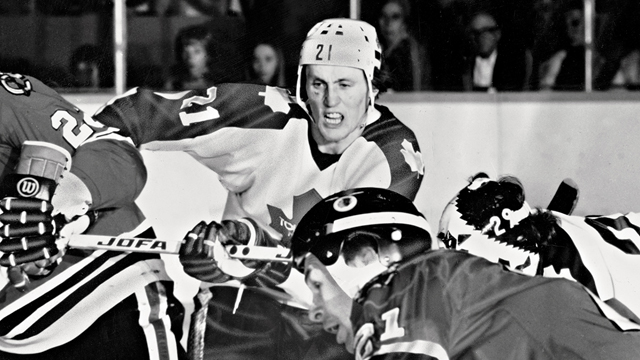Each day from now until the Winter Classic, Sportsnet will count down the greatest Toronto Maple Leafs of all time.
There was no home team when Sweden faced the United States for a 1976 Canada Cup contest at Maple Leaf Gardens, but one player was given a hero’s welcome. When the public address announcer introduced Borje Salming as one of the Tre Kronor’s starting defencemen, the crowd erupted into a raucous ovation that matched, in minutes, the No. 5 on Salming’s back.
A big part of the applause, no doubt, stemmed from the fact that Salming had already spent three seasons with the Maple Leafs and established himself as an NHL star. But there was undeniably something else behind the praise, an acknowledgement that Salming should be recognized for his role in broadening hockey’s horizons.
For Salming, receiving such support while wearing his home nation’s colours clearly struck a chord.
“I was representing my country, and Canadian fans gave me a standing ovation,” Salming said years after the event. “Sometimes hockey has no country.”
It’s easy to understand why it was a poignant moment for a man who overcame the loss of his father as a child, met with violent resistance upon taking his career to North America and whose scarred face ultimately came to represent the unbreakable spirit hockey players everywhere aspire to possess.
Long before being lauded as a pioneer, Salming’s face—then unscathed—was unfamiliar to just about everyone in the Leafs dressing room when he signed as a free agent and landed in Toronto for the 1973–74 season. But Buds forward Ron Ellis had a window into what Salming could offer.
As part of the famous Summit Series in 1972, Team Canada — of which Ellis was a member — also held a pair of games against the Swedish national team. They were high-intensity affairs, and Salming, just 21 years old at the time, was chosen player of the game for his squad in both contests.
“They were very rugged games, they were tough games, and he had no problem,” Ellis says.
Ellis provided his Leafs teammates with a positive scouting report, and it certainly didn’t take long for Salming to validate Ellis’s assessment. He was the quintessential two-way defenceman: gifted offensively and capable of quarterbacking the power play while taking care of the back end with great shot-blocking and poke-checking abilities.
Salming’s terrific vision and deft passing allowed him to rack up 620 assists, the most in franchise history, during his 16 years in Toronto. His career plus-155 rating — all the more impressive considering some of the sad-sack outfits he toiled on during the ’80s — is the best mark posted by any Leaf.
“In practice, we didn’t like to face him one-on-one,” says Ellis with a chuckle. “It was embarrassing.”
Salming may have been able to win over the minds of his teammates with his slick play, but what really captured their hearts was the way he handled himself in the face of ferocious, unprovoked attacks during a xenophobic era in which calls of “chicken Swede” were a nightly occurrence.
Not surprisingly, the team that targeted Salming the most was the Philadelphia Flyers. The roughneck Flyers never required much motivation to inflict pain, but the fact that Salming’s presence in the NHL represented to many the start of an unwanted Euro invasion provided all the more incentive for Philly’s fist-throwing thugs like Dave “The Hammer” Schultz and André “Moose” Dupont to get after the Leafs blue-liner.
Toronto and Philadelphia waged some bloody playoff series in the ’70s, and Salming was often the target of flagrant stick fouls and flying elbows
“It was tough because they really tried to kill you,” said Salming in 1996, when he became the first Swedish player inducted into the Hall of Fame. “If they did some of those things today, they would be suspended for life.”
But even when reflecting on what he went through, Salming made no attempt to curry sympathy, and he certainly didn’t expect any when he was breaking down barriers as a player. That tough-minded approach is largely rooted in the fact that Salming lost his father, Erland, to a mining accident when he was just five years old.
“A lot of other people lost their moms or dads, but for me it meant nobody to coach me, nobody to train with,” Salming said after hitting his 60th birthday in 2011. “The game would be over and the fathers would be there with their sons, and I would be by myself.”
The resilience Salming had to find early in life never left him. When Detroit Red Wings forward Gerard Gallant stepped on Salming’s face during a melee in 1986, it resulted in a gruesome 250-stitch gash, the decision to wear a visor and a return to the lineup just two weeks later.
That Salming’s most prominent scar was the result of accidental action is ironic given all the malicious intent directed his way. And though he was always sage enough to understand his plight as a player was going to be different, Salming’s neck never suffered under the strain of constant cheek-turning. The man nicknamed “King” had the strength of a horse and the body fat of a greyhound, and he certainly didn’t hesitate to reciprocate some of the special treatment he was receiving.
“He took it all and he learned how to give it back,” Ellis says. “He was never what you would call a dirty player, but he stood up to them.”
Little wonder, then, that Canadian fans were so anxious to stand for him that long-ago night in Toronto.


